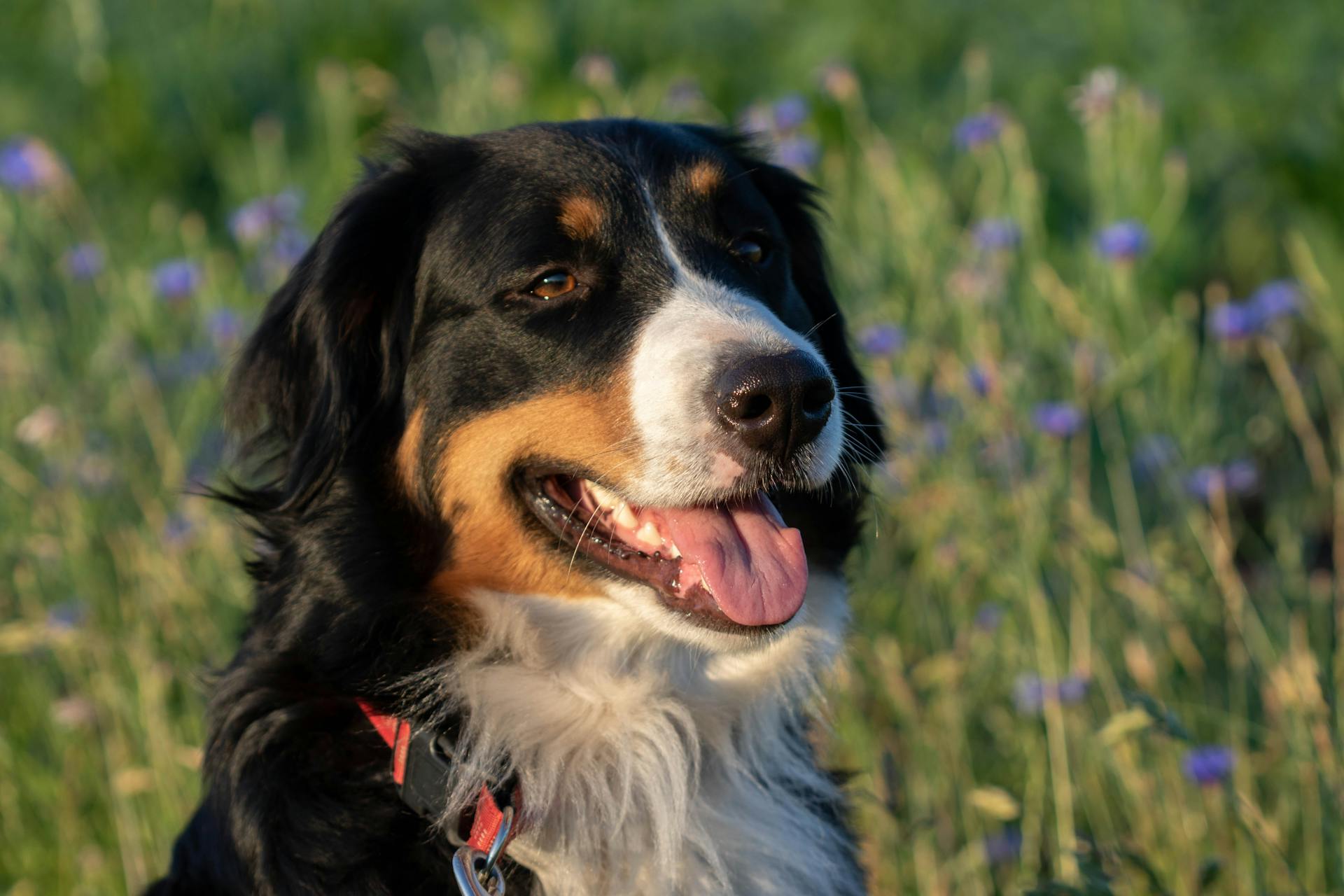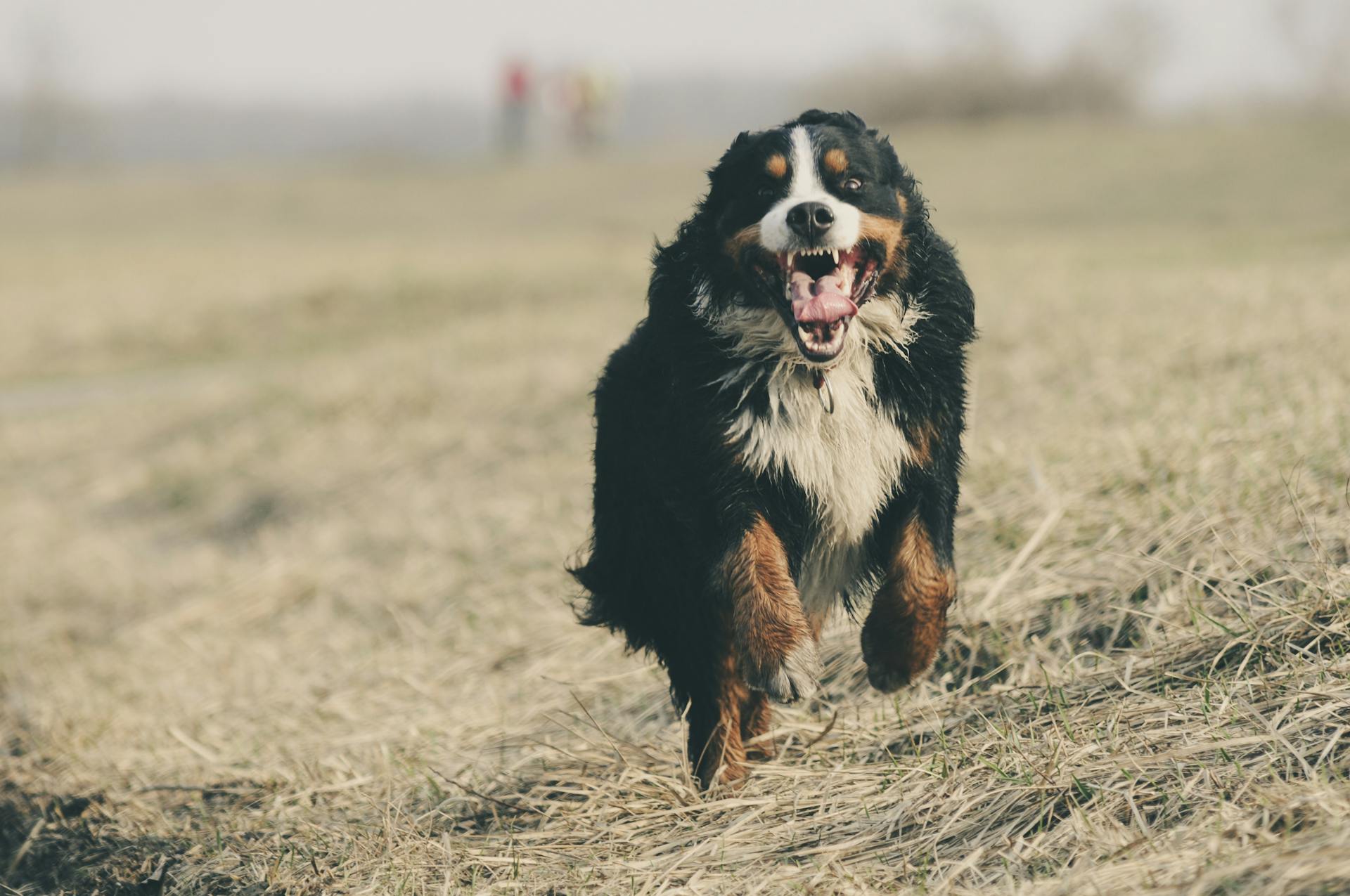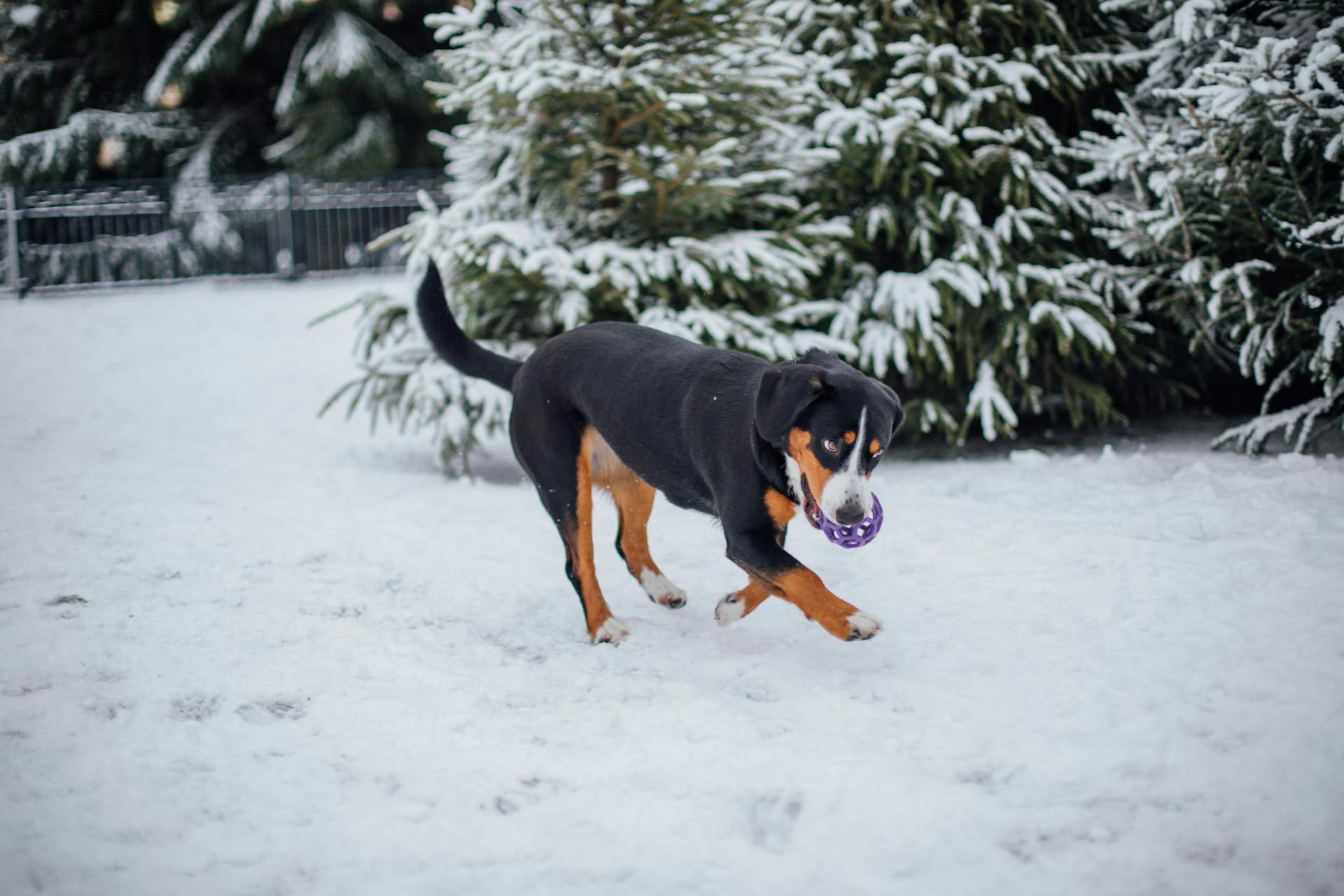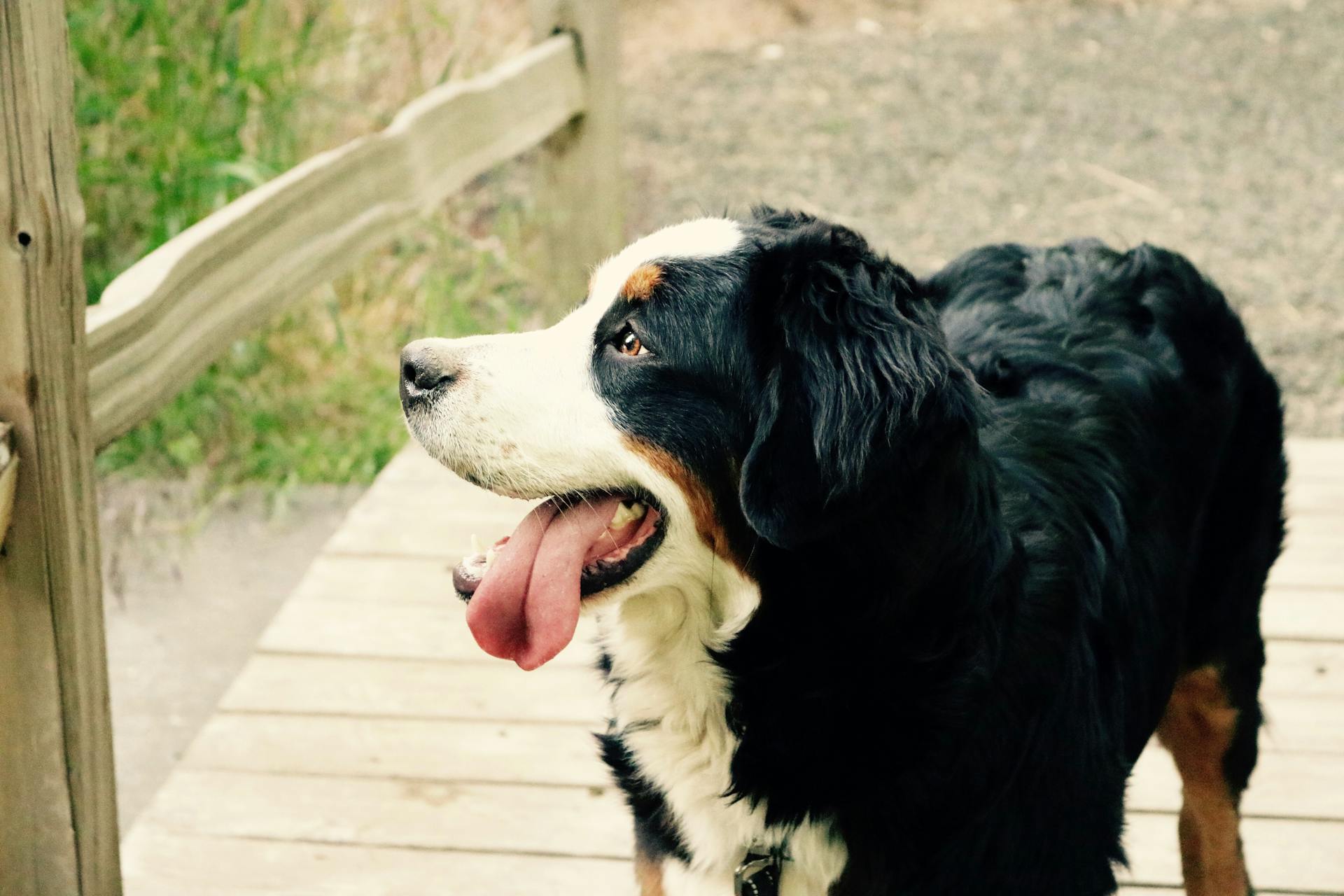
The Berner Sennenhund is a majestic breed that originated in Switzerland, specifically in the canton of Bern. They were bred to pull carts and drive cattle.
These intelligent dogs are known for their loyalty and protective nature, making them excellent companions for active families. They thrive on physical and mental stimulation.
Their distinctive tri-colored coat is a result of their unique genetic makeup, which also contributes to their impressive size, with males weighing up to 120 pounds.
Breed Information
The Berner Sennenhund, also known as the Bernese Mountain Dog, is a sturdy and sociable breed originating from Switzerland. They are a big dog with a strong instinct to migrate, so they need plenty of exercise, especially walking, to keep them at a healthy weight.
The four Sennenhund breeds, including the Berner Sennenhund, are well known in Switzerland and Europe. In the United States, the Berner Sennenhund has become somewhat popular, while the other three breeds are promoted as rare to those seeking unique pets.
Here is a table showing the relative sizes of the four breeds:
Bernese Mountain Dogs
Bernese Mountain Dogs are a beloved breed known for their gentle and intelligent nature. They originated in the Swiss Alps and are often used as search and rescue dogs.
Hercules, a Bernese Mountain Dog, was brought home by Pittsburgh Steelers quarterback Ben Roethlisberger from Switzerland in 2006. He's just one example of the breed's loving and loyal personality.
These dogs are often featured in popular culture, such as in the TV series The New Normal, where the characters Bryan and David own two Bernese Mountain Dogs named Smelly and Harvey Milkbone.
Their intelligence and trainability make them a popular choice for search and rescue missions, as seen with Ohly, a Bernese Mountain Dog who was rescued from a treacherous area in Canada.
Notable Bernese Mountain Dogs include:
- Hercules, owned by Pittsburgh Steelers quarterback Ben Roethlisberger
- Smelly and Harvey Milkbone, owned by characters Bryan and David in The New Normal
- Ohly, a rescue dog from Canada
- Quincey von Wiesmadern, who appeared in videos with Austrian singer Hansi Hinterseer
- Hannah, the inspiration for children's books
- Argus and Fiona, two dogs who were tragically shot and killed
- Izzy, a dog who survived the Northern California wildfires
- Bród and Síoda, the pet dogs of the President of Ireland Michael D. Higgins
- Stella, a dog with two restaurants and a book written about her
Breed Information
The four Sennenhund breeds are well known in Switzerland and the rest of Europe.

The Bernese Mountain Dog is the most popular of the four breeds in the United States, while the others are promoted as rare to those seeking unique pets.
The four breeds have distinct size differences, ranging from 18½–23 in (47–58 cm) in height for the Appenzeller Mountain Dog to 23½–28½ in (60–72 cm) for the Greater Swiss Mountain Dog.
Here's a table showing the relative sizes of the four breeds:
These breeds were originally used as general farm dogs, working as livestock guardian dogs and herding dogs when necessary, as well as guarding the farmers' families, homes, herds, and flocks.
The Bernese Mountain Dog is a natural for pulling small carts or wagons, a task they originally performed in Switzerland.
Curious to learn more? Check out: Sennenhund Type Dogs
History
The Bernese Mountain Dog has a rich history that dates back to a small town called Dürrbach, where the dogs were known as Dürrbachhund or Dürrbächler.
Historically, the breed was used as an all-purpose farm dog for guarding property and driving dairy cattle to alpine pastures. They were also used to transport carts of milk and cheese, earning them the nickname "Cheese Dogs."
In the early 1900s, fanciers exhibited the breed at shows in Berne, and by 1907, a breed club was founded, writing the first Standard that defined the dogs as a separate breed.
The breed gained popularity, and by 1910, there were already 107 registered members of the breed. This growth in popularity led to the breed being recognized by the American Kennel Club in 1937.
The breed is now classified as a member of the Working Group, and in the US, it ranks 22nd in popularity according to the American Kennel Club's 2017 rankings.
Information and Pictures
The Bernese Mountain Dog is a large breed, with males standing between 24 and 28 inches tall and females being slightly smaller. They typically weigh between 80 and 110 pounds.
Their head is broad and flat on top, with a moderate stop, and their ears are medium-sized and triangular. The Bernese Mountain Dog has a strong, wide back and straight legs.
Their coat is tri-colored, primarily black with rust and white markings, and they often have a characteristic white cross on the chest. The Bernese Mountain Dog has a thick double coat, best suited for the outdoors.
They are slightly longer than they are tall, highly muscular, and have a scissors bite. The dewclaws of the Bernese Mountain Dog are often removed.
Here are some key physical traits of the Bernese Mountain Dog:
- Height: 24-28 inches (males), slightly smaller (females)
- Weight: 80-110 pounds
- Head shape: Broad and flat on top
- Ears: Medium-sized, triangular
- Coat: Tri-colored, primarily black with rust and white markings
Health and Temperament
The Bernese Mountain Dog is a breed that's generally happy and easily trainable, but early training is a must to avoid any stubbornness.
They're big, sturdy dogs that require plenty of exercise to curb their instinct to wander and maintain a healthy weight.
This breed is sociable with other pets and affectionate with children, making them an excellent family dog.
However, they don't have a great deal of stamina, so prolonged intensive exercise should be avoided, especially in hot weather.
They're prone to weight gain, so monitoring their diet is crucial to prevent joint problems like hip and elbow dysplasia.
Due to their large size, they grow fast, and until they're two years old, they shouldn't be allowed to run or jump on hard surfaces.
Unfortunately, this breed has a short life expectancy, ranging from 6 to 8 years, due to a high rate of mortality from cancer and joint problems.
Their patient and tolerant nature makes them a great candidate for obedience competition and therapy work.
Despite their health issues, the Bernese Mountain Dog can be a beloved member of your family, provided you're prepared to deal with their inevitable health problems.
Grooming
Grooming is a crucial aspect of Bernese Mountain Dog care, and it's essential to understand their unique needs.
Bernese Mountain Dogs shed year-round, with the heaviest shedding occurring during seasonal changes. This means you'll need to brush their coat more frequently during these times.

A weekly brushing session is usually sufficient to keep their coat neat and reduce the amount of fur on the floor and furniture. However, this may increase to more frequent sessions during spring and fall.
Their coat only requires a bath about once every couple of months, depending on their activity level and how often they get dirty.
The ears of a Bernese Mountain Dog are prone to trapping bacteria, dirt, and liquid, which can lead to ear infections. Regular ear cleanings using a veterinarian-recommended cleanser can help prevent this.
Similar Breeds
The Berner Sennenhund is a part of a larger group of similar breeds that originated in Switzerland. These breeds are known as Sennenhunds.
The St. Bernard, a close relative of the Berner Sennenhund, was one of the first dog breeds to be documented and differentiated from other large farm dogs of the area.
The Berner Sennenhund shares many similarities with the other Sennenhunds, including the characteristic tri-color coat. This can be seen in the examples of the four Sennenhunds, including the Greater Swiss Mountain Dog, Bernese Mountain Dog, Appenzeller Mountain Dog, and Entlebucher Mountain Dog.
The Sennenhunds are all dog breeds originating in Switzerland, and are often referred to as "mountain dogs" due to their origins in the Swiss Alps.
Frequently Asked Questions
How much does a Berner Sennenhund cost?
The cost of a Bernese Mountain Dog (Berner Sennenhund) varies between adoption fees ($700-$2,000) and purchasing from a reputable breeder ($1,000-$2,000).
What is the most common cause of death in Bernese mountain dogs?
Bernese mountain dogs are prone to a higher rate of fatal cancer, which is a leading cause of death in this breed.
Featured Images: pexels.com


